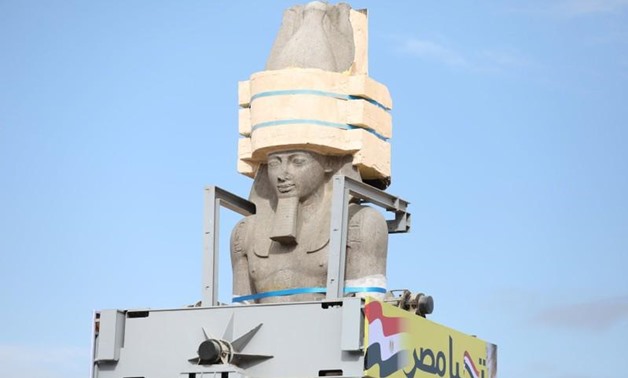
The Statue of King Ramses II is seen on the way to the Grand Egyptian Museum in Cairo, Egypt January 25, 2018. REUTERS/Mohamed Abd El Ghany
Cairo – 26 January 2018: The fourth transfer operation of the King Ramses II statue to the atrium of Cairo’s new Grand Egyptian Museum (GEM) was completed on Thursday. It is the first archaeological piece of the museum's collection and it will be displayed for its partial opening, scheduled for the end of this year.
The ancient Egyptians build the statue of King Ramses II around 3,000 year ago, which was transferred to the open museum at “Miit Rahinah,” in “Memphis,” to be displayed in front of the southern gate of the great temple of Ptah.
The second transfer took place in 1955. The late President Gamal Abdel Nasser ordered to move the statue from “Miit Rahnenah” to “Bab al-hadid” square, as part of an initiative by the former Minister of Defense Abdeul Latef Al-boghdady to embellish streets and squares of Cairo.
The third transfer was in 2006, when the former Minister of Culture Farouk Hosni decided to remove the statue from Ramses Square to protect it from pollution. The new location for the statue was the headquarters of the Grand Egyptian Museum.
The Minister of Antiquities, Dr. Khaled El Anany, said that the transfer was carried out on Thursday in cooperation between the Ministry of Antiquities, the Armed Forces Engineering Authority and the Arab Contractors Company. The transfer operation costs around LE 13.6 million.
Dr. Tariq Tawfiq, the General Supervisor of the Great Egyptian Museum, said that the process of transporting the statue of Ramses II on Thursday confirms that all concerned parties worked together to complete this great edifice. After its grand opening in 2022, this museum will be the largest museum in the world.
He pointed out that the partial opening of the museum will include the Great Hall, the Great Stairs and Tutankhamun hall, which will display for the first time all of the 5,200 gold pharaoh's entire artifacts.
The museum also includes restoration laboratories, conference rooms and a service area that consists of 10 restaurants and 28 shops and a hotel containing 35 rooms.
Italian adventurer Giovanni Cavellia had discovered the statue of Ramses II at “Miit Hostage” in 1820. Cavellia tried to move it to Italy but could not because of the weight of the statue.

Comments
Leave a Comment